RiJ has been working back through the history of Japan tests and this week looks at the famous Japan tour to New Zealand in 1968. Meanwhile, Eddie Jones took the Japan squad to Sugadaira for summer camp recently and RiJ has day-by-day coverage. The Junior Japan squad was also in camp at Sugadaira over the same period.
Enjoy the read.
Ian McDonnell lives and works in Japan. He can be contacted at ianmcdo@apost.plala.or.jp
CONTENTS
- Japan Test Match & Player History Project: Japan Tour to NZ 1968
- Japan Squad: Sugadaira Camp
- Junior Japan Sugadaira Camp
The Japan Test Match & Player History Project
For nine years now RiJ has been documenting Japanese rugby across various levels of the game. More recently, however, RiJ has recognised the need to accurately document the history of Japanese test match rugby and the players that have represented Japan down through the years. With this in mind, RiJ has embarked on a project to write the history of Japanese international rugby, detail every test that Japan has played and profile every player that has represented Japan.
Japan Tour to New Zealand 1968
In May and June 1968 Japan toured New Zealand playing eleven games on tour winning five and losing six. The final game of the tour was played against NSW Colts in Sydney.
Game 1: Otago University 33 d Japan 26, 11 May 1968, Dunedin. (Japan Game Number 44)
Game 2: North Otago 17 d Japan 5, 15 May 1968, Oamaru. (Japan Game Number 45)
Game 3: New Zealand Universities 32 d Japan 19, 18 May 1968, Dunedin. (Japan Game Number 46)
Game 4: Canterbury and Lincoln Universities Combined 41 d Japan 22, 22 May 1968, Christchurch. (Japan Game Number 47)
Game 5: Japan 18 d West Coast 5, 25 May 1968, Greymouth. (Japan Game Number 48)
Game 6: Japan 14 d Auckland University 6, 29 May 1968, Auckland. (Japan Game Number 49)
Game 7: Japan 23 d Poverty Bay 15, 1 June 1968, Gisborne. (Japan Game Number 50)
Game 8: Test v Junior All Blacks.
Game 9: Japan 27 d Victoria and Massey Universities Combined 21, 5 June 1968, Palmerston North. (Japan Game Number 52)
Game 10: Test v New Zealand Universities.
Game 11: NSW Colts 46 d Japan 20, 11 June 1968, Sydney. (Japan Game Number 54)
Junior All Blacks 19 – Japan 23. Monday, 03 June 1968, Athletic Park, Wellington. (Test No.25, Japan Game No.51)
New Zealand Universities 25 – Japan 16. Saturday, 08 June 1968, Athletic Park, Wellington. (Test No.26, Japan Game No.53)
NB: Monday, 3 June 1968 was the Queen’s Birthday public holiday in New Zealand.
This was the first time for the Japan national side to tour New Zealand and only the third ever overseas tour after the inaugural test tour to British Columbia in 1930 followed by another tour to British Columbia in 1963.
The ambitious tour took in ten games across the length and breadth of New Zealand that not only included Auckland, Wellington, Christchurch and Dunedin but also less frequented places such as Oamaru, Greymouth, Gisborne and Palmerston North. In addition, the tourists played a NSW Colts side in Sydney on the return to Japan.
Although Japan finished on the wrong side of the ledger on the tour by winning five and losing six of the tour games, the tour is well and truly written into the history pages of Japanese international rugby for the 23-19 win over the Junior All Blacks at Athletic Park in Wellington on Monday, 03 June 1968. This win, along with the 28-24 win over Scotland XV in Tokyo in May 1989, ranks as one of the greatest wins for Japan on the world stage and over forty years on the result is fondly remembered and still much celebrated with the four tries scored by Yoshihiro Sakata one of the focal points.
The Japanese started off the tour with four straight losses throughout the south island before chalking up the first win of the tour in Greymouth when they beat West Coast 18-5. This must have got the tourists on a roll as this initial win was followed by victories over Auckland University and Poverty Bay as they travelled through the north island in the lead up to the first test in Wellington.
With seven games under their belt, the relatively inexperienced Japanese played themselves into some good form under the coaching of Tetsunosuke Onishi who was in his second year of what would be five straight years in the job. Toyota centre Masayoshi Ozaki was reinstated as captain for the tour after captaining his country against New Zealand Universities in Osaka the previous year.
At 28 years of age Ozaki was the elder statesman in the Japanese side that lined up to face the JAB in Wellington for what was his third international. There were four other players turning out in their third tests while No8 Koji Ishizuka was the most capped played with four caps to his name. There were a further five players on debut including lock Hiroshi Ogasawara and flanker Yoshiaki Izawa who would both go on to earn a total of 24 caps each for Japan.
The JAB led 8-0 early in the game and the result looked beyond doubt even at that stage, but a penalty to 22 year old five-eighth Tsutomu Katsuraguchi followed by a try to Sakata who scored in the corner picking up JAB ball spilt in a tackle narrowed the gap to 8-6. In the 17th minute, Sakata crossed the whitewash for a second time after fullback Laurie Mains fumbled a kick through allowing him to pick up the scraps and put Japan in front. Japan scored two further first half tries through centre Akira Yokoi and Sakata to eventually take a 17-11 lead into the halftime break.
JAB centre Mike O’Callaghan scored the first points in the second stanza with a try in the 16th minute with the conversion making it a one point game with the visitors still holding a 17-16 lead but when Japan scored their fifth try through right wing Tadayuki Ito in the 25th minute the gap was widened to 20-16. In the 30th minute Sakata crossed for his fourth three-pointer of the afternoon to give the Japanese a 23-16 buffer and although the JAB scored a late try from a lineout the visitors held for an historic and well deserved six tries to three 23-19 victory.
The loss did not enhance the prospects for higher representative honours for many in the JAB team although O’Callaghan was an exception as he made his debut later in the season against France. Right wing Owen Stephens would also move up to play his one and only test for the All Blacks against the French before eventually quitting New Zealand rugby for Australia where he would uniquely earn five caps for the Wallabies. In the short term, fate was less kind to Taranaki prop and captain Ashley Gardiner with the burden of the loss all but killing his All Blacks future, though he would eventually earn one cap in the black jersey in 1974 against the Wallabies in Sydney. The 22 year old fullback in Laurie Mains would also have to wait a few more years to play for the All Blacks when he played in three tests against the British and Irish Lions in 1971 while adding his fourth and final cap against the Irish in Wellington in 1976. Mains would also coach the All Blacks from 1992-5, including at the 1995 Rugby World Cup in South Africa.
Japan had previously played New Zealand sides seven times for one draw and six losses. All those games had been played in Japan with the hosts losing the first test in Tokyo in 1936 against NZU before drawing 9-all in Osaka. The JAB won all three tests on their tour of Japan in 1958 and the NZU won both tests in 1967.
In the second test against NZU at the same venue on Saturday, 08 June 1968 it looked like being another shock win for the visitors with Japan leading 13-6 at halftime. However, NZU scored four tries to one in the second half to take the game 25-16 and restore the pride in New Zealand rugby.
Japan Squad: Sugadaira Camp
Sugadaira Camp Day 1
Monday, 16 July 2012
The Japan squad camp at the Sugadaira Highlands in Nagano prefecture started today.
“Sugadaira is a very special place for Japanese rugby and so it is appropriate that we hold this development camp here for the national squad.” Commented head coach Eddie Jones.
The squad arrived at Ueda station by Shinkansen and were greeted by samurai of the local Sanada clan in period costume. Following that there was an official welcome ceremony attended by Ueda city mayor, officials, and children from local rugby schools. The mayor commented that he was glad to welcome the Japan team to Sugadaira for the first time in 13 years and wished them all the best with their preparation.
In response, Japan captain, Toshiaki Hirose thanked the mayor for the wonderful welcome and promised that the squad would train hard.
Once the squad arrived at their hotel there was a general meeting followed by the players getting out on the ground with some of the players experiencing a little difficulty in breathing at the Sugadaira altitude of about 1,300 metres.
With a number of players joining the Japan squad for the first time, the camp got under way in the “Japan Way” at the rugby town of Sugadaira.
Sugadaira Camp Day 1
Monday, 16 July 2012
The Japan squad camp at the Sugadaira Highlands in Nagano prefecture started today.
“Sugadaira is a very special place for Japanese rugby and so it is appropriate that we hold this development camp here for the national squad.” Commented head coach Eddie Jones.
The squad arrived at Ueda station by Shinkansen and were greeted by samurai of the local Sanada clan in period costume. Following that there was an official welcome ceremony attended by Ueda city mayor, officials, and children from local rugby schools. The mayor commented that he was glad to welcome the Japan team to Sugadaira for the first time in 13 years and wished them all the best with their preparation.
In response, Japan captain, Toshiaki Hirose thanked the mayor for the wonderful welcome and promised that the squad would train hard.
Once the squad arrived at their hotel there was a general meeting followed by the players getting out on the ground with some of the players experiencing a little difficulty in breathing at the Sugadaira altitude of about 1,300 metres.
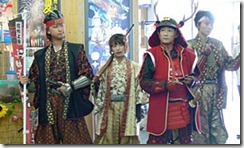
The Japan squad was greeted by samurai of the Sanada clan at Ueda station.
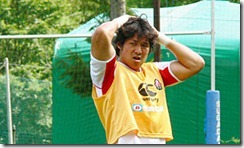
Wing Kosuke Endo joins the Japan squad for the first time this year.
Sugadaira Camp Day 2
Tuesday, 17 July 2012
The first thing on Day 2 was medical checks on the condition of the players. Unfortunately, three players failed their medicals and were replaced in the squad by hooker Ryuhei Arita and prop Hidetatsu Tsuboi from the Junior Japan training squad and fullback Atsushi Tanabe from the Panasonic club.
The day was divided into three sessions focussing on skills and fitness.
There were issues with a high error rate on the opening day of training but in the afternoon session of day two the level of concentration was vastly improved in a highly spirited performance. Before the afternoon session got under way, Tatsuzo Yabe, the chairman of the JRFU greeted the squad and encouraged them to do their best.
To become a top ten country in the world rankings their needs to be consistency in Japanese rugby and this camp gives the players the opportunity to take their game to the next level.
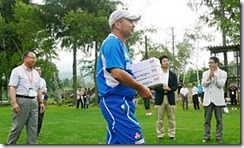
Eddie Jones with Blueberries received from Ueda city officials.
Sugadaira Camp Day 3
Wednesday, 18 July 2012
As on the previous day, with the camp limited to five days, training started at 6 o’clock in the morning and consequently some of the players looked a little bleary-eyed at the beginning of the first session.
However, once activities got under way on the ground the players showed a high level of commitment and concentration.
“This is a very high level of training and the quality is something else and it is tough for me to keep up with the pace and tempo.” Commented Ritsumeikan University lock Kazuhiko Usami who is in the Japan squad environment for the first time. However, from the young players in a Japan squad for the first time like high schooler Takuya Yamasawa through to the veterans of the national team the training at this camp has been extremely challenging for the entire squad. The camp environment also provided an excellent opportunity for young up and coming players to rub shoulders with and get advice from the older more experienced national players.
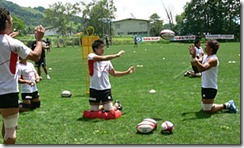
Kazuhiko Usami (on knees) on day three.
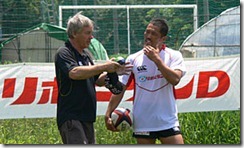
Philip Fowler (spot kicking coach) with Atsushi Tanabe.
Sugadaira Camp Day 4
Thursday, 19 July 2012
In the morning session of day four, the Japan squad was joined by Tsuyoshi Kosaka (42), a retired mixed martial artist.
At 181cm and 105kg was a relatively small martial artist on the world stage but produced some notable wins throughout his career and he conducted a session with the squad based on his “Japan Way”.
According to Kosaka, even though he was comparatively when he was active, much of the success he had was down to ‘going low and ‘speed’.
The players were put through routines that were generally unfamiliar to rugby players using muscle groups not commonly used in rugby. The players were also impressed with the speed and ferocity in Kosaka’s tackles. “I think it is important that we try to use in our rugby what we learned here today.” Commented Hitoshi Ono.
The final word from Kosaka was that even if Japanese players are smaller than their overseas opponents it is important to have the self-belief and confidence that you can win despite the fact the opposition are much bigger, but that hard training is the key to developing this winning confidence and self-belief.
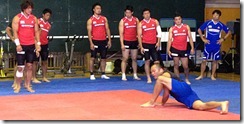
Tsuyoshi Kosaka with the Japan team.
Sugadaira Camp Day 5
Friday, 20 July 2012
Early in the morning on the final day the team went to a nearby waterfall as part of the recovery process for the camp. “It was my first time to go under a waterfall, but it was really refreshing.” Said Sho Takenaka as the players marvelled at the power of nature.
The final field session was carried out for about an hour and tried to incorporate the philosophy of Tsuyoshi Kosaka from the previous day using low body position and speed.
This camp was part of the process of making Japan a top ten ranked country by 2015. The players learned new skills and improved their fitness but once the camp breaks up the players will return to their respective teams and clubs. Regardless, the players have to keep in mind this goal of making Japan a top ten rugby nation in their individual and team training.
In closing, captain Toshiaki Hirose said, “It is not just about the individual, but these players have to pull along their team mates back at their clubs for good things to happen for Japanese rugby.”
Head coach Eddie Jones also said, “This was a good camp. There was a good sense of unity with the veterans showing leadership while the young players enthusiastically showed us what they can do.”
This will be the last time the Japan squad gets together before the autumn tour to Europe in November but the players who attended the camp will soon be in action in top League and other senior divisions as well as the university leagues and high school competition.
Finally, the squad participants thanked Ueda city, the Nagano Prefectural Rugby Union, the people of Sugadaira, the staff at the Sugadaira Kogen Onsen Hotel for making this camp possible.
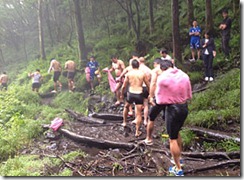
Players returning from the waterfall.
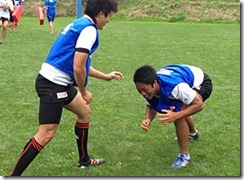
Prop Kosuke Hashino (L) and Takuya Yamasawa at the final session.
Junior Japan Sugadaira Camp
The Junior Japan Squad had a summer camp in the Sugadaira Highlands area of Nagano prefecture from 17-19 July 2012.
Pre-camp Comments by Project Manager Yuzuru Katsuta
In principle, the project plan for the Junior Japan squad is to have developmental activities throughout the year, however, as 2012 is the pilot year we are at present endeavouring to discover the potential in the players. We had four one-day sessions over April to June and with the performances against Tonga on 15 June we have been able to evaluate and assess the players. We also plan to keep a close eye on those players that have just failed to be registered with this current Junior Japan squad.
A number of players have already been called up to the full Japan national squad from Junior Japan. There are a lot of players in Japan with potential but there is a necessary advancement in training methodology needed and also a necessary change in thinking to make Japan a top ten ranked country. In this respect, we want to focus on strength and conditioning and skills with the Junior Japan squad. Then, it is not only the players, but we also have to develop the coaching staff in order to realise the goal of getting Japan into the top ten in the world rankings.
At Sugadaira, there are a number of university based players that could not make the camp due to pre-existing commitments to their universities, but over the three days of the camp we want to fully concentrate on training. We will also have some combined sessions with the Japan national squad who are also in camp here in Sugadaira over the same period and the national squad staff will also help monitor what training is necessary so as to unify the approach across the two squads. The Junior Japan squad is training only about 300 metres away from where the national squad is based and this close proximity should inspire the younger players to strive to become full national players themselves.
Forwards
| Name | Club | Age | Hgt/Wgt |
| Kengo KITAGAWA | Doshisha Univ. | 19 | 178/110 |
| Masataka MIKAMI | Toshiba Brave Lupus | 24 | 178/113 |
| Kohei YOSHIDA | Toyota Verblitz | 22 | 184/106 |
| Ryuhei ARITA | Coca-Cola West Red Sparks | 23 | 176/100 |
| Yoshikatsu HIKOSAKA | Tsukuba Univ. | 21 | 179/100 |
| Atsushi SAKATA | Teikyo Univ. | 19 | 180/98 |
| Hidetatsu TSUBOI | Chugoku Electric Power | 23 | 181/115 |
| Shoya MATSUNAMI | Meiji Univ. | 20 | 186/110 |
| Shinnosuke KAKINAGA | Waseda Univ. | 20 | 180/110 |
| Takuma ASAHARA | Toshiba Brave Lupus | 24 | 179/114 |
| Yoshiki NIIZEKI | Kubota Spears | 22 | 193/112 |
| Naohiro KOTAKI | Teikyo Univ. | 20 | 194/100 |
| Hiroki TERATA | Meiji Univ. | 19 | 194/92 |
| Yuta ONODERA | NEC Green Rockets | 22 | 190/104 |
| Kyosuke HORIE | Meiji Univ. | 22 | 182/100 |
| Shinya OSUGI | Meiji Univ. | 19 | 187/92 |
| Yuto NISHIUCHI | Hosei Univ. | 19 | 180/90 |
| Noriya KOBAYASHI | NTT Communications | 28 | 185/105 |
| Shoma MAKINOUCHI | Higashi Fukuoka HS | 17 | 199/95 |
| Ryota HASEGAWA | Daito Bunka Univ. | 19 | 188/95 |
| Yoshitaka TOKUNAGA | Kwansei Gakuin Univ. | 20 | 185/90 |
Backs
| Name | Club | Age | Hgt/Wgt |
| KIM Chul-Won | Kintetsu Liners | 28 | 171/76 |
| Kotaro NAKAO | Waseda Univ. | 20 | 177/81 |
| Kota IWAMURA | Doshisha Univ. | 18 | 180/75 |
| Jumpei OGURA | Waseda Univ. | 20 | 172/72 |
| Kazan WATANABE | Doshisha Univ. | 18 | 177/74 |
| Seiyu KOHARA | Tokai Univ. | 19 | 182/85 |
| Masakatsu HIKOSAKA | Tsukuba Univ. | 19 | 177/90 |
| Hideto KONDO | Tokai Univ. | 19 | 178/90 |
| Hikaru TAMURA | Meiji Univ. | 18 | 175/80 |
| SO Kaku | Meiji Univ. | 21 | 185/91 |
| Aisea HAVEA | Kintetsu Liners | 23 | 176/100 |
| Shunsuke NUNOMAKI | Waseda Univ. | 20 | 178/90 |
| Keisuke MASUDA | Toshiba Brave Lupus | 24 | 183/96 |
| Kosuke HASHINO | Canon Eagles | 24 | 176/80 |
| Rikiya MATSUDA | Fushimi Technical HS | 18 | 177/75 |

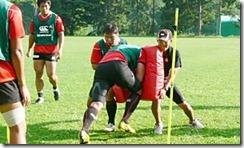

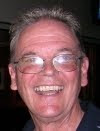



No comments:
Post a Comment